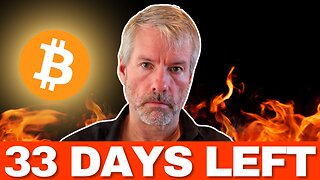Premium Only Content

Dr. Russell Blaylock: How Vaccine-Induced Spike Proteins Damage the Brain and Cause Cancer
Dr. Russell Blaylock: How Vaccine-Induced Spike Proteins Damage the Brain and Cause Cancer
Nov. 22, 2022
"This [Covid] injection is an injection of artificial exosomes … The brain is one of the most complex things in the entire universe... [The medical profession] really doesn't understand this injection. They don't understand what it does to the neurological apparatus of the brain and spinal cord," Dr. Russell Blaylock told Brian Hooker of Children's Health Defense.
Retired American neurosurgeon Russell Blaylock appeared on Children's Health Defense's 'Doctors & Scientists' for an in-depth presentation about the effects of spike proteins on the body. He shared shocking discoveries about neurological damage, cancer rates, cardiac arrest and other exacerbating health issues as well as their connection to mRNA technology.
His presentation titled 'Spike Proteins and Neurodegeneration: Effect of artificial exosomes on the nervous system in the form of an injection' covers the damage the spike protein does to the brain, the elderly and unborn children. He explained in detail the mechanisms that cause the damage and used several published papers to demonstrate the harm. He ends with some advice for those who have been vaccine-injured.
Further resources: Russell L. Blaylock's research while affiliated with Belhaven College and other places, ResearchGate
The following is based on Dr. Blaylock's presentation in the video above. The section titles are our own but the content follows the same order as his presentation. Our section titles are:
Microglia, Cytokines, Chemokines and Excitotoxins
Immunosenescence in the Elderly
Effects of Spike Proteins on the Central Nervous System
Effects on Unborn Children
Mechanisms that Cause Cancer
Sudden Cardiac Death
What Can People Who Have Had Covid Injections Do?
Microglia, Cytokines, Chemokines and Excitotoxins
With all vaccines, and this injection in particular, if you stimulate the peripheral immune system within minutes there's microglial activation in the brain – the brain's primary immune cell. This is what Dr. Blaylock describes as "sickness behaviour."
When there's systemic inflammation or any kind of trauma occurs in the body, it produces inflammation and activation of the immune system. This sends a signal to the brain within minutes and starts activating the microglia which is the inflammatory, cytotoxic cell in the brain.
The image below illustrates the different stages of microglia. At the top of the image is a ramified microglia which is "normal," it has not been stimulated. It used to be called a "resting microglia" but that's not an accurate term. The pseudopodia are constantly extending and retracting to analyse the extracellular space for invaders, changes in chemical content etc., explained Dr. Blaylock.
When there is a stimulation of the immune system the ramified microglia go to the primed microglia stage. The pseudopodia are retracted and it becomes a more rounded-looking cell. Inside the primed microglia, there is an intense upregulation of cytokine, chemokine and excitotoxin production – but they're not released from the cell so there may be some minor immune reaction but otherwise there's not much sign of a reaction. "That's what would happen with the first injection of this injectable they call a 'vaccine'," Dr. Blaylock said. It is important to note that chemokines attract macrophages, or white blood cells, to the brain. A macrophage in the brain looks exactly like microglia and can also undergo priming.
"With the second immune stimulation, [which would be the second injection and] which can be months later, that primed microglia become fully activated. And when that happens it releases all these toxic components... you get chronically activated microglia, [an] overactivated state and there's a 3-fold higher inflammatory reaction than you'd normally get with microglial activation."
When microglia get the second immune stimulation, for example after the second injection or further boosters, and release high levels of destructive elements it damages, for example, the dendrites, cell membranes, mitochondria and the DNA. "And so, it can produce a lot of damage to that neuron," Dr. Blaylock said.
When you get an infection and recover from it, microglia shift from the activated state back to the ramified state. In the ramified state, instead of releasing harmful chemicals the microglia release neurotrophins that repair the damage done during the activated state.
Immunosenescence in the Elderly
It is important to be aware of immunosenescence, or imflammaging, in the elderly whereby immune cells begin to age and change, and immune cells don't reproduce themselves and become highly inflammatory. This also happens to microglia and astrocytes, star-shaped glial cells in the brain and spinal cord. Senescent microglia have an impaired ability to fight viruses while producing high levels of inflammatory mediators and excitotoxins. "So, in the aged person this reaction is infinitely magnified," said Dr. Blaylock, "senescent astrocytes … leak excitotoxins so that adds to the problem."
"This whole senescence occurs in males more than females which explains why you see more problems in males like in autism spectrum disorders as well as in neurodegenerative disorders."
Not only do an aged person's immune cells produce higher levels of inflammatory cytokines but they also secrete much lower levels of the reparative neurotrophic compounds. "So, the aged person has a much worse reaction and less ability to repair the neurons after an attack than a young person. That's why ageing is the number one risk factor for neurodegenerative disorders," Dr. Blaylock said.
"The spike proteins, because they're constantly stimulating these cells in the brain as well as systemically, are producing an increase in levels of [or accelerate] immune senescence."
READ MORE: https://expose-news.com/2022/11/22/how-spike-proteins-damage-brain-cause-cancer/
Source: https://rumble.com/v1v7udi-sickness-behavior-the-effect-of-spike-proteins-on-the-body.html
-
 2:53:12
2:53:12
Right Side Broadcasting Network
6 hours agoLIVE REPLAY: White House Press Secretary Karoline Leavitt Holds a Press Briefing - 8/28/25
84.4K35 -
 1:38:09
1:38:09
Simply Bitcoin
3 hours ago $0.97 earnedIs This Your LAST Chance to Buy Bitcoin Before the GENERATIONAL Bull Run Begins? | EP 1320
6.46K -
 LIVE
LIVE
StoneMountain64
1 hour ago#1 WARZONE TACTICIAN + New Battlefield Trailer
157 watching -
 20:03
20:03
Adam Does Movies
2 hours agoAlien: Earth Episode 1 - Recrap
47 -
 15:38
15:38
IsaacButterfield
10 hours ago $0.12 earnedExploiting His Baby For Views (The Island Boys)
9387 -
 32:09
32:09
The Boomer Effect
6 hours agoBuy American and Build America
3 -
 1:59:46
1:59:46
The Charlie Kirk Show
3 hours agoShould Taylor Swift Submit? + What's Wrong In Minneapolis? + MAHA vs. CDC | 8.28.2025
43.9K19 -
 50:23
50:23
The White House
2 hours agoPress Secretary Karoline Leavitt Briefs Members of the Media, Aug. 28, 2025
28.7K23 -
 1:01:34
1:01:34
Timcast
4 hours agoCatholics Targeted By TRANS Shooter, Left Blames CHRISTIANITY
154K108 -
 2:09:57
2:09:57
Steven Crowder
5 hours agoTotal Failure: Unpacking The Media's Evil Reaction to the Minneapolis Church Shooting
335K308